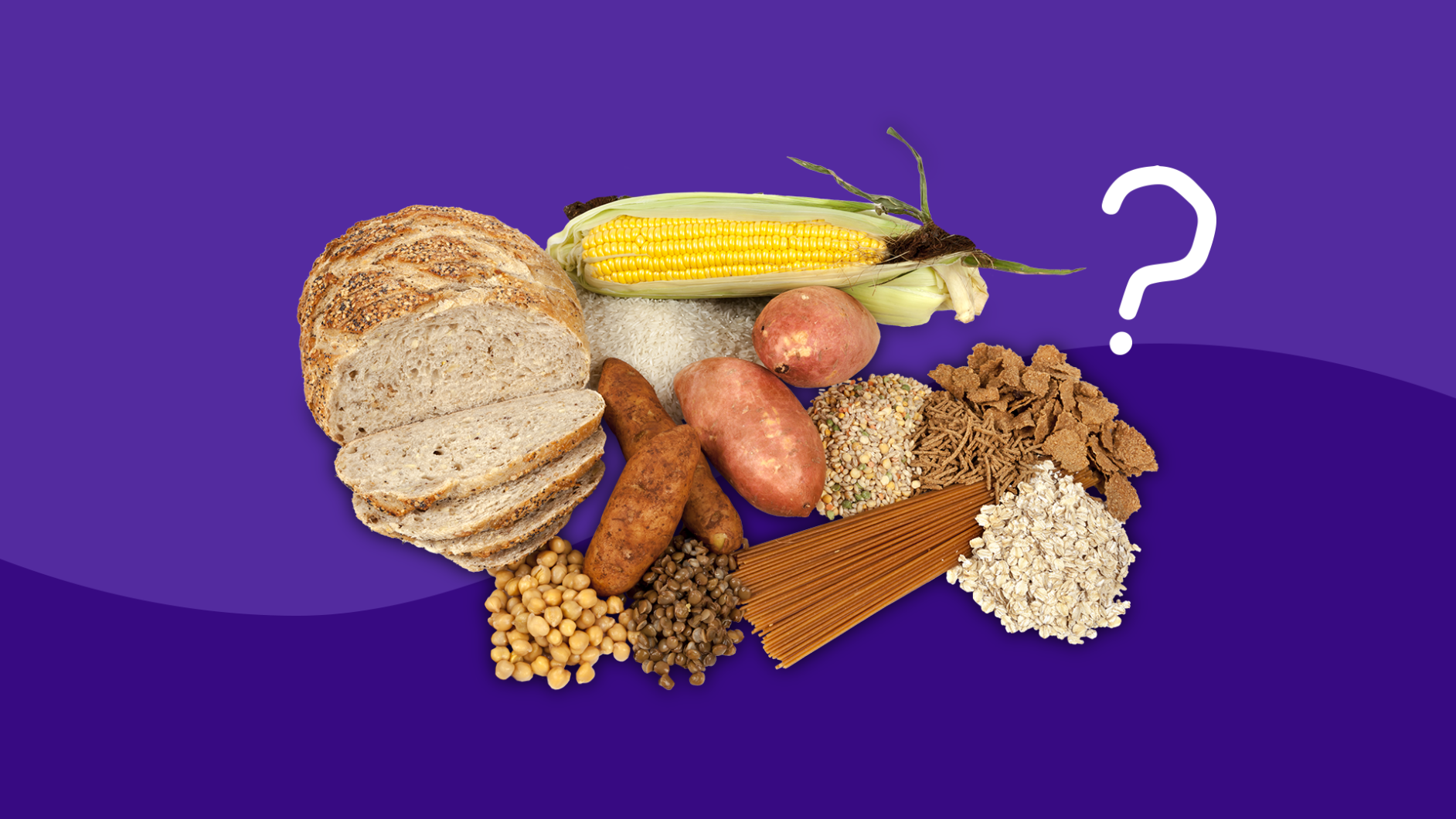Picture this… You’re driving around, looking for a dinner spot, and Olive Garden catches your eye. The hostess offers a friendly welcome, but you can only focus on the sign next to her: the Never Ending Pasta Bowl. It’s glorious. And before you know it, you’re waist-deep in fettuccine Alfredo, penne bolognese, three-cheese lasagna, and baskets of breadsticks.
You leave full and satisfied, ready for a nap. But that belly full of pasta comes with a body full of carbohydrates.
There’s no shortage of conflicting viewpoints about this frequently-mired macronutrient. You’ve likely read about them in weight loss blogs, healthy diet recommendations, or high school health textbooks, varying sources that might label them as everything from the main weight gain culprit to an indispensable source of energy. But what, exactly, are carbohydrates? What do they do? Should you load up or keep your distance?
This is the essential guide to carbs, everything you need to give them a healthy place in your daily diet. So, next time you’re downing plates of whole grains or pastries, you’ll know exactly what you’re getting into.
What are carbohydrates?
For most people, the term carbohydrates conjures images of sugary treats, bread, and pasta. This is correct, but carb types and functions are a lot more nuanced. Carbohydrates are the body’s primary energy source. They’re one of the three macronutrient building blocks in a diet, along with fats and proteins. Carbs are in a multitude of different foods, from starches like white bread to grains like lentils, to fruits and vegetables.
At the molecular level, they’re constructed from carbon, hydrogen, and oxygen, which combine in different ways to form one of two compounds: aldehydes or ketones. These compounds often form chains called polymers or polysaccharides. As the digestive system works on carbohydrate polymers, enzymes break them down into the simple sugar glucose, which is absorbed into the bloodstream and delivered to the body’s cells. These cells will either use glucose as fuel right away or store it for later.
There are three main types of carbohydrates:
Sugars
These are carbs in their most basic form. They’re called monosaccharides (simple sugars) and include glucose, fructose, and galactose. Foods containing monosaccharides often taste sweet because taste buds recognize them as sweet. Simple sugars are found in:
- Honey
- Corn syrup
- Candy
- Fruits and fruit juices
- Some vegetables
When two monosaccharide sugars bind together, they form disaccharides like lactose, sucrose, and maltose. Some examples are:
- Table sugar
- Dairy products
- Beer
- Some bread
- Root vegetables like sweet potatoes and carrots
Starches
Not all carbs are sweet, though. Foods like bread, pasta, and grains are rich in polysaccharides–longer chains of glucose. These carbohydrates are often stored in the muscles or liver and converted later to expend energy, which is why endurance athletes use them to “carb load,” increasing their carbohydrate intake before a big race or other rigorous physical activity. Starch is found in:
- White or whole grain bread
- White or brown rice
- Quinoa
- Pasta
- Corn
- Potatoes
- Couscous
- Other grain foods
Fibers
Dietary fiber is different from the other two types of carbohydrates (sugar and starch) because the body can’t digest it. There are two kinds of fiber: soluble (dissolves in water) and insoluble (passes through undigested). The body uses and stores other carbs as energy, but fiber serves different purposes. Soluble fiber helps regulate blood sugar levels and cholesterol levels, while insoluble fiber assists in the digestive processes. Some abundant sources of dietary fiber include:
- Fruits
- Vegetables
- Beans and other legumes
- Nuts and seeds
- Barley
- Oatmeal
Simple vs. complex carbohydrates
Carbohydrates are everywhere. There are various types that differ in structure, function, and effects on the body. However, all the carbs listed above can be classified as simple or complex. How? It’s all about their molecular composition.
Simple carbohydrates
These are straight from the “sugars” section above. They’re monosaccharides and disaccharides that the body can absorb fairly quickly, causing increased blood glucose levels. People have long associated simple sugars with a “sugar rush,” followed by a crash. However, studies have discovered that consuming sugary foods can actually cause short-term fatigue instead. This “crash” can be accompanied by irritability, lightheadedness, drowsiness, headaches, and other symptoms.
Processed foods with added sugar such as candy, soft drinks, corn syrup, and desserts contain the most potent amounts of simple carbohydrates. But they’re also found in certain fruits, vegetables, grains, and dairy products.
Complex carbohydrates
Here we have the polysaccharides, the extended chains of carbs with longer digestive processes. These are the starches and fibers listed above, typically found in grains, fruits, starchy vegetables, legumes, and nuts.
Most often, complex carbohydrates are healthier than simple carbs, according to Claudia Hleap, RD, LDN, who runs a private practice in Philadelphia. They’re “more difficult for the body to break down into individual sugar molecules, and therefore, have a more moderate impact on blood sugar and insulin levels in the body. Complex carbohydrates have more dietary fiber, which is essential for gut health and blood sugar management,” she says. Even so, Hleap maintains that “all foods can fit in the diet in moderation.”
Good vs. bad carbohydrates
Low-carb diet fads have given many people the misconception that all carbohydrates are bad. While these diets can work wonders for some, it doesn’t mean that carb-heavy foods should be thrown out altogether. The truth is that carbohydrates can be either good or bad. It all depends on the source.
“Carbohydrates have been unnecessarily vilified,” says Jo Lichten, Ph.D., RDN, a wellness expert and speaker and the author of Dr. Jo‘s Reboot. “With two-thirds of American adults now overweight or obese, there’s a need to cut back. On carbohydrates, yes, and everything else, too. Carbohydrates are no more or less responsible for weight issues. Too much food and not enough activity is.”
How many carbohydrates does a person need per day?
Dietary guidelines suggest that carbs should make up 45%–65% of a healthy diet—that’s between 225 and 325 grams for a standard 2,000 calorie diet. “The brain is dependent on glucose for energy,” says Hleap. “So it is essential that we consume enough carbohydrates to supply the body with what it needs.”
There is a variety of carb sources, some better than others. The ones to avoid are processed or “refined” carbs that have been stripped of dietary fiber, vitamins, and other nutrients. This includes white flour, white rice, pastries, bagels, pizza dough, white pasta, fruit juices, and most desserts. Instead, opt for “whole” carbohydrates like fruits and vegetables, beans, nuts, seeds, brown rice, and whole-grain bread or pasta.
So, despite what certain diets might suggest, simply eating carbohydrates won’t automatically cause weight gain. But excessive empty calories from refined carbs can. Weight gain is less likely from smart carb sources and unrefined foods. People with other health problems, like prediabetes or Type 2 diabetes, should be especially careful. Simple, refined carbs are high on the glycemic index. They cause quick spikes in blood sugar levels, leading to potentially serious complications. Fibers, on the other hand, can help regulate blood sugar as well as cholesterol.
Low-carb vs. high-carb diets
In the past decade, media, celebrities, health clubs, and others have pegged carbohydrates as the key to weight loss. The question is, do these diets work, or are they just passing fads?
Low-carb diet
The goal of these diets is a metabolic state called ketosis (hence, the “keto diet“). By dramatically reducing the amount of carbohydrates consumed, the body is forced to find another fuel source: fat. Entering ketosis, the body will burn its fat stores, dropping body fat levels. Many times, low-carb dieters will be encouraged by short-term results as they lose significant water weight and begin to shed fat. And a low-carb diet could help reduce unhealthy intake of refined carbs.
Some studies have connected low-carb diets to greater weight loss than traditional methods, while others say that, in the long run, they facilitate the same results as balanced-diet approaches. They can even present certain undesirable side effects and, according to one recent study, shorten a person’s lifespan.
Hleap warns against eliminating an entire macronutrient in an effort to lose weight. “When you cut an entire food group out of the diet,” she says. “You are putting yourself at risk for nutritional deficiencies and their associated symptoms, including possible lethargy, weakness, mental fogginess, constipation, and/or neuropathy.”
Lichten agrees that carbs are necessary for holistic health. “When you don’t eat enough carbohydrates, the body will turn the protein we eat into glucose,” she says. “But unfortunately protein doesn’t have all the same nutrients that carbohydrates do, like vitamin C, vitamin A, B vitamins, and more. Proteins do not have any fiber, which is important for gastrointestinal health and preventing colon cancer.”
High-carb diet
Opposing the current online diet landscape, one recent study showed that a high-carb, low-fat diet actually yielded better weight loss results. Of course, the subjects in this study weren’t binging on doughnuts and pasta. Rather, they were eating a plant-based diet with plenty of natural, complex carbs, and fibers. Eating a high-carb diet based on unhealthy, refined carbs can actually achieve the opposite–weight gain and increased risk for cardiovascular disease, Type 2 diabetes, high blood pressure, high cholesterol, and more. Healthy high-carb diets haven’t had the same publicity as their low-carb counterparts, but when employed correctly, it appears they might be the healthier long-term option. After all, a large portion of one’s daily diet should be healthy, unrefined carbs anyway. In the long run, high-complex carb diet may be easier to maintain than a very low-carb diet.
Unsure whether a carb source is healthy or unhealthy? Check the nutrition label. Not only does it list total carbohydrates, but it also shows how much of that total is comprised of dietary fiber, sugar, and added sugar. Beware of foods that have a high proportion of sugars and added sugars. High fiber, on the other hand, usually indicates a healthier carb.
Bottom line: Have your cake, but eat it mindfully
Even though the internet is saturated with articles about carbohydrates, all proclaiming their own miracle solutions (they’re bad, they’re good, eat them, don’t eat them, etc.), Hleap maintains that it’s all about balancing diet and consuming in moderation. “There is no need to characterize something as ‘good’ or ‘bad’ or completely restrict anything from the diet. The ‘diet-mentality’ is often characterized by restriction and guilt,” she says. “Many diet guidelines are effective for weight loss but are not sustainable, so most people end up regaining all the weight they lost, sometimes even more than they lost.”
Instead, she proposes a “non-diet” approach, which “means you don’t have to restrict anything from the diet, but it is important to prioritize healthy foods that keep you feeling comfortable and full,” Hleap says. “These foods are whole-grain carbohydrates, fruits, lean proteins, and non-starchy vegetables. So, if you want a cookie, have it! But eat healthy balanced meals most of the time and eat mindfully.”











